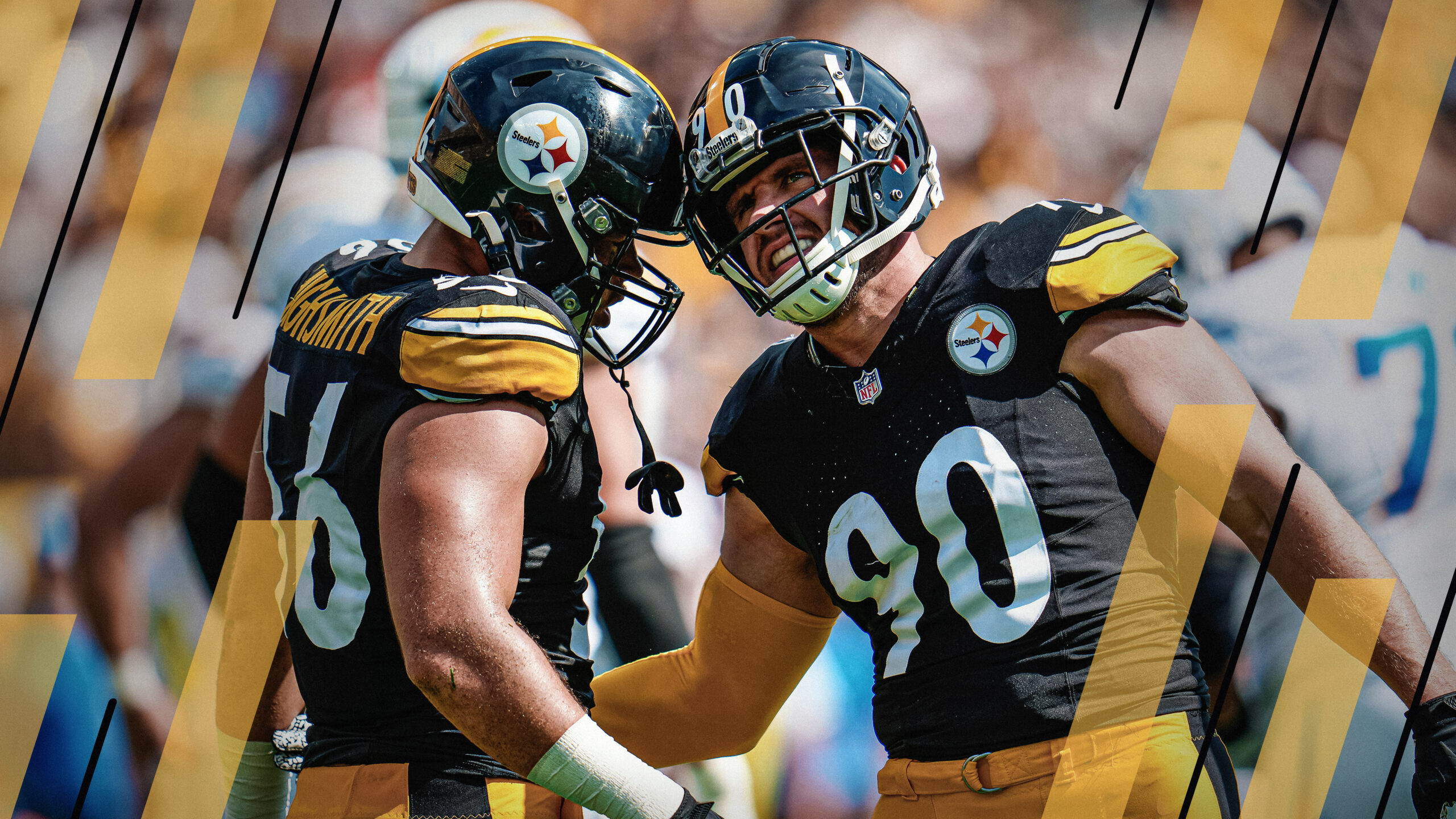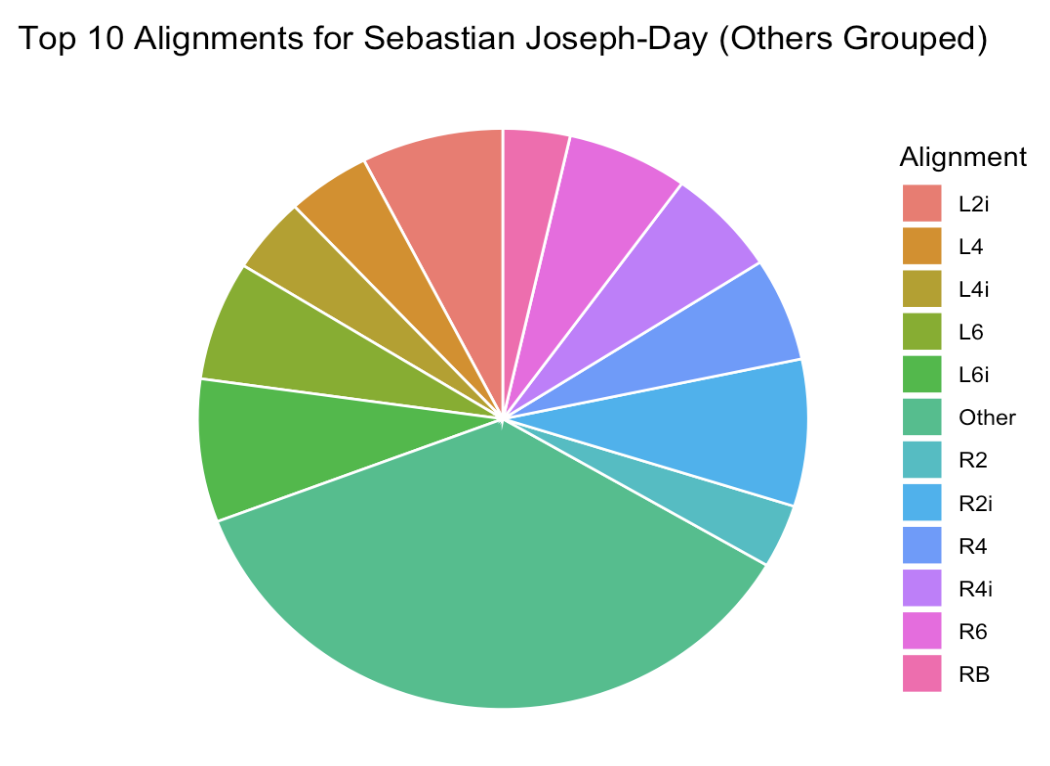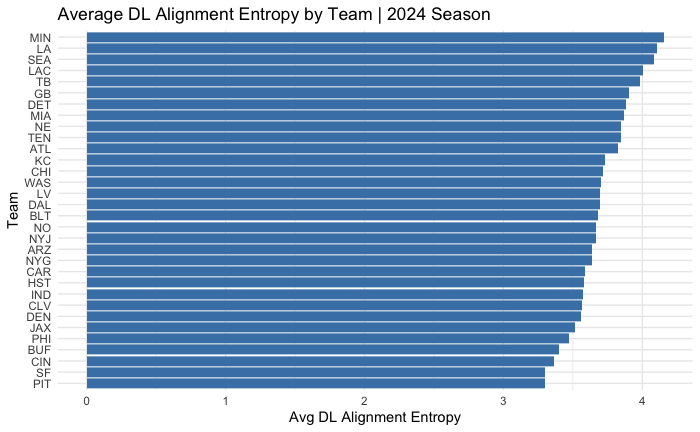Measuring defensive line alignment versatility: A potential edge for NFL defenses

By
- What entropy tells us about NFL defensive linemen: Edge defenders tend to move around more than interior defenders, and several edge rushers thrived in a role where they moved across the line in 2024.
- The Steelers’ pass rush was elite — and predictable: Despite posting the league’s top PFF pass-rushing grade in 2024, the Steelers ranked just 14th in pressure rate with low alignment entropy scores across the board, suggesting offenses were able to anticipate and counter their rush plans.
- Subscribe to PFF+: Get access to player grades, PFF Premium Stats, fantasy football rankings, all of the PFF fantasy draft research tools and more!
Estimated Reading Time: 8 minutes

The trench battle plays a critical role in deciding football games, and the first questions I often start with when breaking down a trench matchup are: Where is the team’s best defensive lineman lining up, and what does that individual matchup look like?
That’s easier to predict for some teams than others.
Former PFF data scientist Eric Eager wrote five years ago about the use of Shannon entropy to quantify unpredictability in football. That study looked at safety alignment versatility, and a similar approach can be applied to defensive linemen alignment to highlight which players moved up and down the line and which players had fairly static roles.
The defensive technique (designation of where the defensive lineman lined up in relation to the offensive line, as seen in the diagram below) alone isn’t enough to find that alignment versatility because it doesn’t take the side of the line into account. For example, a 3-technique can align over the outside shoulder of the right guard or the left guard.

To deal with that, I pulled the side of the line (L for left side of defense and right side of offense, R for right side of defense and left side of offense) from the PFF play position and combined it with the technique to find the entropy values of those alignment combinations.
We won’t get into the weeds of the math here, but a higher entropy value correlates with a player who lines up in many spots (defensive line technique and side of the line, in this case) with a relatively even usage split. A lower entropy value correlates with a player who lines up in similar alignments more frequently.
Below are the top 20 defensive linemen (with at least 100 snaps played) from the 2024 season in alignment versatility, per the Shannon entropy calculation.
Defensive Linemen with Highest Alignment Versatility in 2024 | Min. 100 Snaps Played
| Player | Entropy | Most Common Alignment |
| Pat Jones II | 4.76 | L4 (7%) |
| Keion White | 4.74 | R4i (9%) |
| Tyree Wilson | 4.74 | R6 (9%) |
| Zaven Collins | 4.69 | L8 (8%) |
| Za’Darius Smith | 4.66 | L8 (8%) |
| Sebastian Joseph-Day | 4.66 | R2i (8%) |
| Tyquan Lewis | 4.65 | R8i (9%) |
| Tuli Tuipulotu | 4.65 | L8 (10%) |
| Andrew Van Ginkel | 4.61 | L8i (10%) |
| Deatrich Wise Jr. | 4.59 | R7 (9%) |
| Derick Hall | 4.58 | R8i (8%) |
| Michael Hoecht | 4.56 | L8o (10%) |
| Dre’Mont Jones | 4.56 | L8i (11%) |
| Denico Autry | 4.55 | L5 (9%) |
| Dallas Turner | 4.54 | R8i (11%) |
| Roy Robertson-Harris | 4.53 | R4i (10%) |
| Chauncey Golston | 4.53 | L7 (12%) |
| Jalyn Holmes | 4.46 | L4i (11%) |
| Dayo Odeyingbo | 4.43 | L8i (12%) |
| Charles Omenihu | 4.42 | R6 (11%) |
The first thing that jumps out is that this list consists primarily of edge defenders, which checks out. There is more flexibility for different alignment widths/techniques on the edge, which naturally creates more opportunity for those players to widen out and condense down. Still, the edge rushers who do show up here largely fit the mold of the types of players we expect: edge rushers who can kick inside situationally and play on both sides of the line of scrimmage.
That natural bias toward edge rushers who can move around and kick inside makes someone like Sebastian Joseph-Day’s appearance at sixth on the list noteworthy.

Joseph-Day played a fairly even split of snaps from 2i- (inside shade of guard) to 6-technique (head-up on tight end) across both sides of the line of scrimmage last season with the Tennessee Titans, serving as a valuable piece to their run defense (77.7 PFF run-defense grade).
It also shouldn’t come as much of a surprise that three Minnesota Vikings edge rushers show up on the list — Pat Jones II (first), Andrew Van Ginkel (ninth) and Dallas Turner (15th). Brian Flores’ defense has prioritized showing different pre-snap looks at the line of scrimmage, and the alignment versatility possible with players like those three helps make that happen. Minnesota will have to replace Jones heading into next season after he signed with the Carolina Panthers in free agency.
Defensive Linemen with Lowest Alignment Versatility in 2024 | Min. 100 Snaps Played
| Player | Entropy | Most Common Alignment |
| Javon Hargrave | 2.23 | R2i (43%) |
| Khyiris Tonga | 2.37 | 0 (57%) |
| Eddie Goldman | 2.42 | L1 (35%) |
| Roy Lopez | 2.44 | 0 (55%) |
| Kevin Givens | 2.54 | R2i (39%) |
| Tommy Togiai | 2.65 | R2i (38%) |
| Michael Pierce | 2.68 | R2i (34%) |
| Kalia Davis | 2.74 | LB (30%) |
| Linval Joseph | 2.76 | R1 (37%) |
| Jaquelin Roy | 2.79 | 0 (31%) |
| Jordan Elliott | 2.80 | R2i (38%) |
| Mike Pennel | 2.81 | RA (26%) |
| DeWayne Carter | 2.84 | LB (32%) |
| Jordan Phillips | 2.84 | R2i (36%) |
| Jordan Davis | 2.85 | R2i (34%) |
| Cameron Heyward | 2.86 | R4i (32%) |
| Jordon Riley | 2.86 | R1 (29%) |
| Javon Kinlaw | 2.87 | L4i (35%) |
| McKinnley Jackson | 2.87 | R2i (27%) |
As expected, the players with the lowest alignment versatility are interior defensive linemen, particularly nose tackles with a strict, well-defined role in the defense. We see a handful of players on this list (Khyiris Tonga, Roy Lopez and Jaquelin Roy) whose most common alignment is as a 0-technique, lined up directly over the center.
The group’s only two players whose most common alignment comes outside of the B-gap (at least shading the inside shoulder of the tackle) are Cam Heyward and Javon Kinlaw.
Heyward’s inclusion is noteworthy because it speaks to a larger trend for the Pittsburgh Steelers, who had the lowest average entropy value of any defensive line in the NFL last season.

Heyward lined up between the inside shoulder of the left guard (R2i) and a head-up alignment on the left tackle (R4) on 86% of his snaps. T.J. Watt’s snaps come almost exclusively outside of the right tackle, opposite Heyward, and Alex Highsmith’s snaps come almost exclusively outside of the left tackle.
Here is where Pittsburgh’s top defensive linemen ranked in entropy out of 333 defensive linemen who played enough snaps to qualify.
Pittsburgh Steelers’ Defensive Linemen Entropy Ranks in 2024 | Out of 333 Qualifiers
| Player | Entropy Score | Rank |
| Keeanu Benton | 3.31 | 251st |
| T.J. Watt | 3.17 | 264th |
| Alex Highsmith | 3.12 | 277th |
| Larry Ogunjobi | 2.89 | 313th |
| Cam Heyward | 2.86 | 318th |
Pittsburgh finished with the highest team PFF pass-rushing grade in the NFL last season, but just the 14th-highest pressure rate.
We can interpret that in a few ways. It’s easy to make an argument that a core of Watt, Highsmith, Heyward and Benton (now adding first-round rookie Derrick Harmon into the mix in 2025) gives Pittsburgh the most talented defensive front in the NFL.
But offenses were able to game-plan around that advantage, particularly late in the 2024 season. It’s easier to take a Defensive Player of the Year-caliber player like Watt out of the game when you know where he’s going to be on every snap. The numbers that show how often teams chipped Watt back that up.
On the other end of the spectrum, several edge rushers thrived in a role where they did move across the defensive line. Will Anderson Jr., Jonathan Greenard, Yaya Diaby and Jared Verse all finished in the top 40 among defensive linemen in alignment entropy score (out of 300-plus qualifiers) and in the top 15 at their position in PFF WAR.
This isn’t to say that it’s necessary to constantly shuffle players around up front, but in recent years, we have seen defenses more often move players such as Micah Parsons, Myles Garrett and Chris Jones to hunt matchups and give them favorable one-on-ones. In a game where you spend all week trying to unearth the smallest of edges, it’s easier to find them when you know the hand your opponent is going to play.








